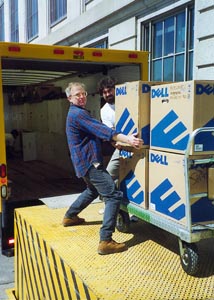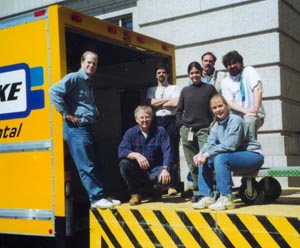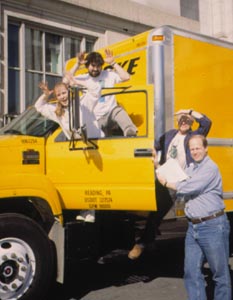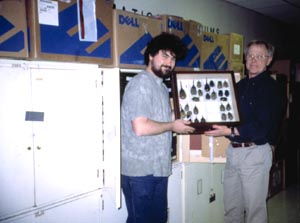The national collection of scarab beetles
(minus dung beetles), a part of the vast insect collections of the
U.S. National Museum of Natural History at the Smithsonian Institution
in Washington, D.C., was transferred in March 1999 to the University
of Nebraska State Museum as a long-term loan (part of a Smithsonian
program of off-site enhancement). Dr. Brett C. Ratcliffe, Curator of
the Division of Entomology at the State Museum, and Dr. Mary Liz Jameson,
Visiting Assistant Professor in the Museum, concluded negotiations
with the Dept. of Entomology at the Smithsonian Institution (through
Dr. David Furth, Collections Manager and other Smithsonian staff) to
bring the collection to Lincoln for a ten year period. This compliments
the NSF/PEET program of scarab research by Ratcliffe and Jameson to
study New World scarab beetles, train graduate students, and study
the phylogenetic relationships of the higher taxa.
 |
Mary Liz Jameson (left), Karla Villatoro, and Andrew Smith at the National Museum of Natural History preparing part of the scarab collection for shipment to Nebraska, March 1999.
Photo by Brett Ratcliffe. |
The taxonomic research entailed in this grant, in combination with
the formation of a team of scarab specialists by Ratcliffe and Jameson,
provided the foundation for bringing the national collection to the
University of Nebraska. The objectives of the NSF grant include training
students in scarab systematics, producing identification guides to
selected groups of scarab beetles, conducting evolutionary analyses
of scarabs, and producing an identification guide to the approximately
320 genera (representing thousands of species) of New World scarabs.
Nebraska is now an even more prominent world-class center for conducting
research on this group of beetles (containing approx. 35,000 species),
and the results of the NSF grant will provide the foundations for future
research in the largest and most poorly studied groups. The research
program in the Museum's Division of Entomology currently has, in addition
to Drs. Ratcliffe and Jameson, two Ph.D. (Andrew Smith from Canada
and Federico Ocampo from Argentina) and two M.S. students (Karla Villatoro
from Guatemala and Aura Paucar from Ecuador) working on monographic
revisions and the classification of scarabs. In summary, there is no
other place in the world where there is this amount of scarab research
being conducted. As a result, there is no better place for curating,
identifying, and databasing the national collection.

|

|
Brett Ratcliffe (left)
and Andrew Smith transferring scarabs into the rental truck
at the National Museum of Natural History loading dock, March
1999.
Yes, the picture is posed.
Photo by Karla Villatoro. |
Brett
Ratcliffe in heaven . . . sorry . . . inside the rental truck
with part of the national collection of scarabs, March 1999.
The truck became completely full after
this photo was taken.
Photo by Karla Villatoro. |

|

|
Scarab moving day at the
Smithsonian. From the left, David Furth (Entomology Collections
Manager), Brett Ratcliffe, John Nay (Logistics and Supply Manager,USNM),
Karla Villatoro, Leo Mastromatteo (Volunteer, USNM), Mary Liz
Jameson, and Andrew Smith, March 1999.
Everyone is dead tired.
Photo by Stephen Gaimari. |
The scarab collection
loan invoice from the Smithsonian to Nebraska indicated, under
number of packages, one.
You are looking at it.
Photo by Brett Ratcliffe.
.
.
.
. |
The national collection included nearly a third of a million specimens
and was contained in approx. 1,100 glass-topped drawers. "Team
Scarab"
at the University of Nebraska State Museum traveled to Washington for
a week in mid-March 1999 to prepare the collection for shipment to
Nebraska by truck. Another grant from NSF provided $38,000 for new
specimen cabinets in which to place the national collection when it
comes to Nebraska. Now begin the tasks of curating, identifying, and
electronically databasing the national collection so that the scientific
data associated with the specimens can be readily retrieved. In addition,
the collection will provide a fabulous opportunity to train graduate
students in research, curation, databasing, and managing an internationally
important scientific resource. The national collection, combined with
those already at Nebraska, will give Nebraska one of the largest and
most comprehensive collections of its kind in the world. It will serve
as a magnet in attracting other scientists who wish to study this material
through loans or by on-site visits to the collections.

|

|
With the loading completed,
Team Scarab and Dave Furth relax by displaying the secret
sign of the Sacred Order of the Lamellate Antennae, the
lamellate wave, complete with stridulation.
Photo by Karla Villatoro. |
The collection is safely
delivered
to the Division of Entomology
at the Unviversity of Nebraska
State Museum, March 1999.
See, Bob, there was
no breakage.
Photo by Mary Liz Jameson. |
Overall, the products of this proposed off-site enhancement would benefit
the National Museum of Natural History, the research program at Nebraska,
and a large community of scientists beyond both institutions. The off-site
enhancement at Nebraska would return the national collection to world-class
status.

|
The new home for
the next few years for the Smithsonian's pleurostict scarabs:
Scarab Central at the Division of Entomology of the University
of Nebraska State Museum.
Photo by Brett Ratcliffe. |
For additional information, write to Dr. MJ Paulsen (mjpaulsen@unl.edu)
at Nebraska or Dr. David Furth (furth.david@NMNH.SI.edu)
in Washington. |




